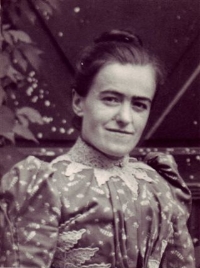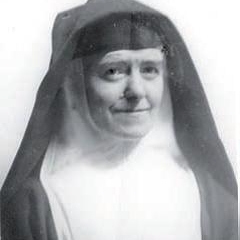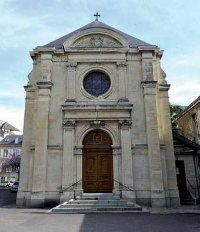July 2, 2015: Bishop Boulanger presides at solemn opening of cause for beatification and canonization of Leonie Martin, the sister of St. Therese, at the Visitation Monastery in Caen
/At 9:30 this morning, in the chapel of the Monastery of the Visitation at Caen, Mgr Jean-Claude Boulanger, Bishop of Bayeux and Lisieux, solemnly announced the opening of the process of beatification and canonization for Leonie Martin, Sister Francoise-Therese, a religious woman, a member of the Order of the Visitation of the Blessed Virgin Mary who entered that monastery in 1899 and died there in 1941. Born in Alencon in 1863, she was the older sister of St. Therese of Lisieux and the third daughter of soon-to-be-Saints Louis and Zelie Martin, who will be canonized on October 18, 2015.
"The cause of beatification and canonization of the Servant of God Sister Françoise-Thérèse is actually launched," said Bishop Boulanger. The cause was opened in the presence of Father Antonio Sangalli, O.C.D., an Italian Carmelite friar who has been appointed postulator of Leonie’s cause and who supervised the preparations for opening the process.
In the same chapel, on January 24, 2015, the feast of St. Francis de Sales, Bishop Boulanger, presiding at a special Mass, announced his intention of seeking permission from the Congregation for the Causes of Saints in Rome to open the diocesan inquiry for Leonie’s beatification. He had received the concurrence of the bishops' conference of Normandy at their meeting on January 22, 2015. Leonie was designated “Servant of God,” which title is the first step the long road to canonizable sainthood.
For the solemn opening of the process, the monastery chapel was full. (See photographs of today's ceremony). For this special occasion the Visitation nuns sat in the front pews. Their community, which is the "acteur" in the cause, joined Father Sangalli in asking Bishop Boulanger to open the cause. In this chapel, 115 years ago today, on July 2, 1900, Leonie made her religious profession. She had entered the monastery twice before (in 1887, staying six months, and in 1893, staying two years) before her definitive entrance on January 28, 1899 at the age of thirty-five.
Bishop Boulanger set up a diocesan tribunal to inquire into the virtues Leonie practiced during her lifetime, and the members of the tribunal were sworn in. The postulator, Father Sangalli, is responsible for advancing the “inquiry” (a kind of trial) to verify that the documents about Leonie are authentic. Without the postulator, no inquiry can be opened. Father Sangalli has served in this role before; he is the vice-postulator for the cause of beatification and canonization of Leonie’s parents, Blessed Louis and Zelie Martin. "I studied the whole biography of Leonie. By reading what she wrote and what is written about her, I got the idea that she might be a saint.” He called her “the saint of the twenty-first century.”
The road to canonized sainthood is long. The Church generally waits at least five years after a candidate’s death to consider such a trial. At the time of Therese’s death, the usual waiting period was 50 years, but Therese was dispensed from that wait. Leonie Martin has waited 74 years. This first inquiry, the “diocesan process,” is also sometimes called the “bishop’s process” or the “ordinary’s process.” It is opened with the permission of the Congregation for the Causes of Saints in Rome, but under the authority of the bishop of the diocese in which the candidate died. The tribunal is an ecclesiastical court which is granted authority to investigate the candidate's life and reputation for sanctity.
Therese’s diocesan inquiry was opened in August 1910, and Leonie testified at it. The testimony of most of the witnesses at this process was published in 1973 as the book “St. Therese of Lisieux by those who knew her.” Louis Martin’s was opened on March 22, 1957, and Zelie Martin’s on October 10, 1957.
Many witnesses are expected to testify during the inquiry, Father Sangalli said. Since Leonie’s death in 1941, letters have come in from all over the world (the Americas, Africa, Europe, etc.) to ask for Leonie’s prayers and to ask her to obtain graces. “These are the elements of holiness we need to collect. Now the historical commission is going to organize all the archives, collecting all the possible documentation imaginable. It's going to divide the stages of her life--birth, family, adolescence, schooling---from a chronological point of view, to establish vis a vis Leonie whether in her lifetime she truly practiced the Gospel.” The inquiry will determine whether Leonie practiced the Christian virtues to a heroic degree.
The tribunal’s work is expected to take a year or two, after which Bishop Boulanger will convoke a final session of the church court to close this phase of the process. The documentation would then be sent to Rome, where the Church wil decide definitively whether Leonie practiced heroic virtue. If the finding is favorable, she would be called “Venerable.” The decree for Therese’s heroic virtues was promulgated on August 14, 1921 by Pope Pius XI; the one for the virtues of Louis and Zelie, by Pope John Paul II on March 26, 1994. For Leonie’s cause then to proceed to beatification, the Church would need to recognize a miracle attributed to her intercession.
When Leonie died on June 17, 1941, she was given the honor of being buried in the crypt of the monastery. For decades pilgrims came there to pray at her tomb. In view of the process, Leonie's body was exhumed on April 25, 2015. It will not be returned to the crypt, but is expected to be placed in a reliquary in the chapel, which is at street level and more accessible to pilgrims.
Read more:
About the rise of devotion to her since her death
Sources for this article:
http://www.ouest-france.fr/religion-ouverture-du-proces-en-beatification-de-leonie-martin-3530774


